#field service module
Explore tagged Tumblr posts
Text
Space Station Concepts: Space Operations Center
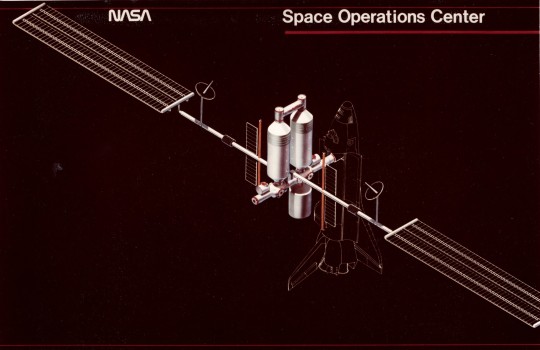

"The SOC is a self-contained orbital facility built up of several Shuttle-launched modules. With resupply, on-orbit refurbish- ment and orbit maintenance, it is capable of continuous operation for an indefinite period. In the nominal operational mode, the SOC is manned continuously, but unmanned operation is possible.
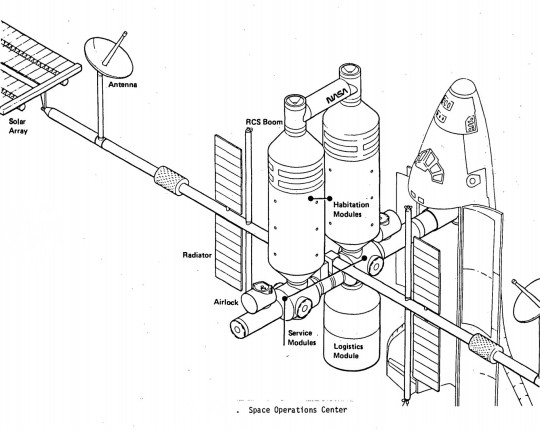
The present mission management and control process is characterized by a people-intensive ground monitoring and control operation involving large supporting ground information and control facilities and a highly- integrated ground-flight crew operation. In order to reduce dependence on Earth monitoring and control, the SOC would have to provide for increased systems monitoring; fault isolation and failure analysis, and the ability to store and call up extensive sets of data to support the onboard control of the vehicle; and the onboard capability for daily mission and other activity planning."

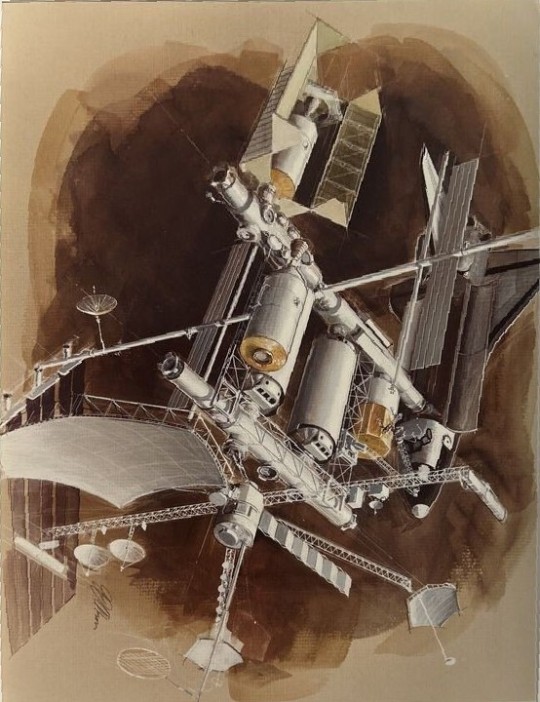

"Like most other space station studies from the mid/late 1970s its primary mission was the assembly and servicing of large spacecraft in Earth orbit -- not science. NASA/JSC signed a contract with Boeing in 1980 to further develop the design. Like most NASA space station plans, SOC would be assembled in orbit from modules launched on the Space Shuttle. The crew's tour of duty would have been 90 days. NASA originally estimated the total cost to be $2.7 billion, but the estimated cost had increased to $4.7 billion by 1981. SOC would have been operational by 1990.
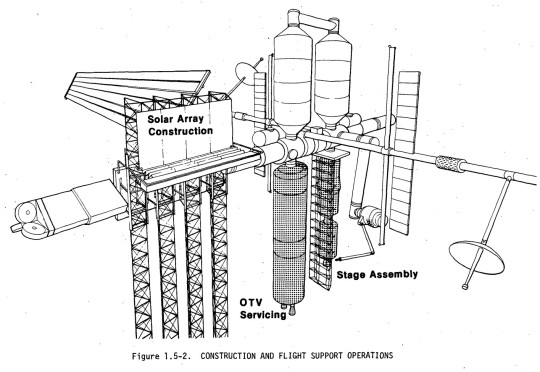


NASA's Johnson Spaceflight Center extended the Boeing contract in February 1982 to study a cheaper, modular, evolutionary approach to assembling the Space Operations Center. An initial power module would consist of solar arrays and radiators. The next launches would have delivered a space tug 'garage', two pressurized crew modules and a logistics module. The completed Space Operations Center also would have contained a satellite servicing and assembly facility and several laboratory modules. Even with this revised approach, however, the cost of the SOC program had grown to $9 billion. Another problem was Space Operations Center's primary mission: spacecraft assembly and servicing. The likely users (commercial satellite operators and telecommunications companies) were not really interested in the kind of large geostationary space platforms proposed by NASA. By 1983, the only enthusiastic users for NASA's space station plans were scientists working in the fields of microgravity research and life sciences. Their needs would dictate future space station design although NASA's 1984 station plans did incorporate a SOC-type spacecraft servicing facility as well."
Article by Marcus Lindroos, from astronautix.com: link

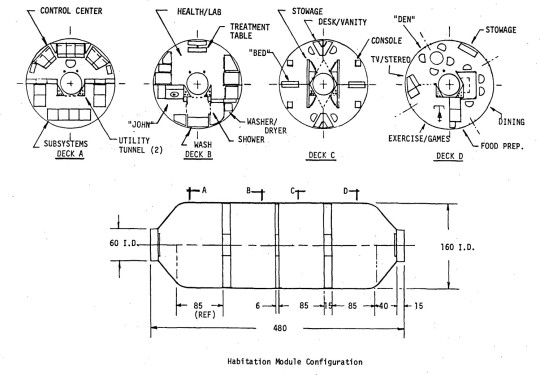


NASA ID: link, S79-10137
Boeing photo no. R-1859, link, link
#Space Operations Center#Space Station Freedom#Space Station Concept#Space Station#Concept Art#Space Station Program#Space#Earth#Space Shuttle#Orbiter#NASA#Space Shuttle Program#1979#1980s#my post
458 notes
·
View notes
Text
New Event PV
youtube
New Operators

Rose Salt, 5* Welfare Multi-Target Medic
If i find a way to get super rich, i'm sure you'll get your share.
Tecno, 5* Shaper Caster (new branch)
Whether anyone can see it or not, the crystals are still there, but i'm still standing.
Thorns the Lodestar, 6* Alchemist Specialist
I hear the waves crashing at the sides of the boat, heralding our victory.
With this ship at the center, i will interpret my own Iberia.
Operator Outfits Update





Total of 4 new outfits, 1 new addition for the MARTHE brand, 2 new additions for the Shining Steps brand and 1 new addition for the Icefield Messenger brand
MARTHE
Wiping Knife - Cutter (Login Event)
Shining Steps
Dreaming High - Ray
Top Tier Live - Tequila
Icefield Messenger
Inviting Snow - Harold
Harold's outfit will be up for sale during The Rides to Lake Silberneherze Retrospect



Announced outfit reruns
Series V and VI Icefield Messenger outfits (Erato, Greyy the Lightningbearer, Goldenglow, Tsukinogi, Qanipalaat, Penance)
Epoque outfits of Kjera and Puzzle
Operator Modules Update



Rose Salt being part of the Multi-Target Medic branch immediately gets her module
RIN-X module base effect gives Rose Salt an additional tile of range up front
Arts Fighter Guard branch gets 3 module types
Module 1 given to Surtr, Vina Victoria, Guard Amiya and Mousse
Module 2 given to Astesia and Sideroca
Module 3 given to Viviana
Exusiai gets her 2nd module
MAR-Y module base effect increases Exusiai's ASPD by +8 when there are ground enemies within her attack range
Events and Stories
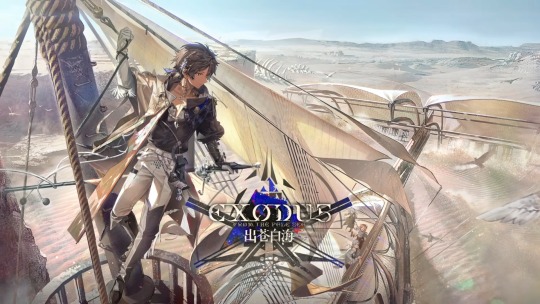
Exodus from the Pale Sea, an Iberia side story event
The traveler who is guided by reason returns to his homeland without common sense.
He saw ships without oars traveling across a sea without water, men without desires hoisting sails without direction,
Saw a man who begged for death condemning himself to live, and a man who was robbed of everything by the sea leaving everything behind and running toward the sea.
How should he understand it, and what can he do to change it?
Uh well, first he has to figure out how to deal with the chains on his body and the gallows not far away, right?


The Rides to Lake Silberneherze Retrospect, scheduled after Exodus from the Pale Sea
Poly Vision Museum, limited time mini-games event, scheduled after The Rides to Lake Silberneherze Retrospect

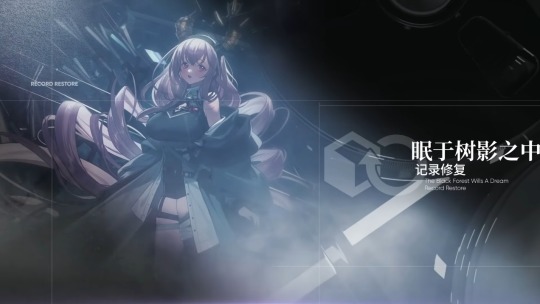


Operator Archives update for Rose Salt, Tecno, Ceylon and Courier
Record Restore update for The Black Forest Wills a Dream, What the Firelight Casts and Where Vernal Winds Will Never Blow
Misc Stuff


New QoL features
Players will be able to set their birthday in-game and receive birthday rewards
Added special operator voicelines for birthday and new year's day
Added the ability to have multiple assistant operators in rotation and main menu loadouts to switch between assistant rotation and backgrounds and UI themes

New SSS QoL changes
After clearing at least one floor of an SSS mission without a support unit, players can use 2 [Regular Affairs Proxy Cards] to skip an SSS run get rewards based on highest floor completed [PRTS Proxy Annihilation Cards] players get from missions are converted to [Regular Affairs Proxy Cards], they can still be used to skip annihilation Older SSS maps will be rerun
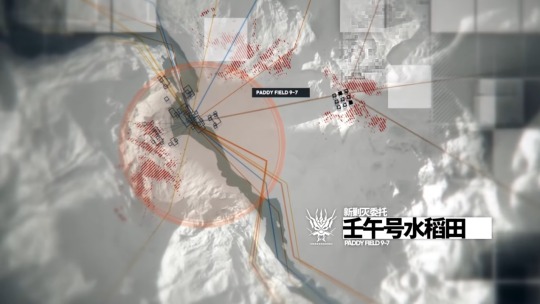

Annihilation #29 - Paddy Field 9-7, annihilation mission with Here a People Sows enemies and mechanics
SSS New Season #7, Concert Security Service - Leithanien Philharmonic Association & Area Under Construction For Dossoles

Erato and her potential tokens along with Perfumer's [Species Plantarum] Outfit will be available in the certs shop to players that don't have them
39 notes
·
View notes
Text
Looking to make one more of, well similar to what's below here.
There were on the other blog, brief examples of muses to come. And sort of what I want to make one more of, not exactly a fan kid but just a muse related to someone's, but that can act on their own.

Isra Parsa - Ghazal Parsa's sister (Adventurersdelight)
A moon witch with plenty of brain and little stamina. Magically strong, physically tired. Often returns home to help her sister with longer missions where perhaps hiring outside help may be troublesome. Like Natalia Naess or Kitagawa Ida, one of the few with a proper 'title' of witch. Has trouble keeping her sister in check however.

Markdown - Older model of Protos (muse-matrix)
Older budget prototype, related to the similar other units you've seen lately. Does not have advanced language modules, thus either speaks in PRINT: or Expresses statements or status updates with SPAN:. Rather stoic due to this fact, and never seen without her large hat for additional processing.

Livia Giordano - Human daughter of Beatrice (magicaldreaming)
A sheltered yet energetic young woman with plenty of brains for curiosity but not a lot for actually seeing things through. A thousand plans, but always calling on Madre for help. Often is away at boarding school, where the others mock her for her fashion and curiosity. But at home, she's funneled endless joyful things to play with and study.

K. Lethe - Daughter of two hard to perceive woman (ariaofsinfulnight)
Though it's a slight secret who her mothers are, it's a little obvious. A youkai? With the ability to modify her perception about her and her actions. You won't forget her, and if she releases her perception in the middle of something, you'll remember and experience everything at once. A 4 foot queen, with a very scatter brain demeanor

Angelica Dawnstar - Sister of Valeria Dawnshield (adventurersdelight)
Ange for short, but only for her big sister. A member of the same order that her sister has carved a name out for herself. A member who travels from village to village for ceremonies, service, and to find others who may wish to join. Away from home often, a bundle of joy when she gets to stay home for a few weeks, always glued to her sister's side.

Meztli - Only daughter of Gladyss and her ex-lover (ebb-n-fl0w)
A studious biologist and nature witch in training, often the one who has to listen to all her mother's woes, and sometimes her drunken more intimate woes. By all visual standards, she's merely a human, though with incredible blood in her veins she has yet to awaken much from her mothers' genes.

Misery Moonfall - Rhapsody's sister (lewdadventuretime)
Originally born to a vampire nobles, a rare occurrence of a vampire born with such poor vampire genes, that she was almost human or basically human. Played off as a maid's daughter, she would live and serve her life as Misery. Diligent, beautiful, emerald eyes would draw the attention of the nobles oldest daughter Rhapsody. On her way out, leaving the castle to make her own harem she would claim Misery as hers, for her harem and turning her into a vampire. Unknowingly sinking her fangs into her failed sister, and dragging her lovingly into her harem.

Priscille Leduc - Sister of Niles Leduc (goldenshxrds)
A shy royal academy 'witch' and small prosthetics tinkerer. Though nowhere near the level needed to merit stressing about her brother's legs, she has taken it upon herself to maybe one day become an expert in such a magic/medicine field for similar things.
7 notes
·
View notes
Text
Training of Farmer Producer Organisations by M2i Consulting
In recent years, Farmer Producer Organisations (FPOs) have emerged as a crucial model for empowering small and marginal farmers in India. These organizations help farmers gain better access to markets, financial services, and agricultural inputs, ultimately improving their livelihoods. However, for FPOs to function effectively and sustainably, proper training and capacity-building initiatives are essential. M2i Consulting plays a vital role in this regard by offering specialized training programs tailored to the unique needs of FPOs.
Why is Training Important for FPOs?
Enhanced Management Skills: Effective governance and leadership are essential for the success of an FPO. Training programs help in developing managerial skills among FPO members.
Financial Literacy: Many small-scale farmers lack knowledge about financial management, bookkeeping, and accessing credit facilities. Training helps bridge this gap.
Market Linkages: Understanding supply chain dynamics, price negotiation, and quality control can significantly improve the revenue generation of FPOs.
Sustainable Agricultural Practices: Training ensures that farmers adopt eco-friendly and efficient farming techniques, leading to better productivity.
Policy Awareness: Awareness about government schemes, subsidies, and regulatory compliance ensures that FPOs can leverage available benefits.
How M2i Consulting Supports FPOs
M2i Consulting is a leading organization with a strong focus on training and capacity-building programs for FPOs. Their approach includes:
Customized Training Modules
M2i Consulting designs training modules that cater to the specific needs of different FPOs, ensuring relevance and effectiveness.
Hands-on Capacity Building
Training sessions involve interactive workshops, field visits, and case studies to provide practical learning experiences.
Financial and Business Management Training
M2i helps FPOs understand bookkeeping, cash flow management, and financial sustainability, enabling them to manage funds efficiently.
Market Access and Value Chain Development
Through strategic training, FPOs learn how to establish direct market linkages, negotiate better prices, and improve the value chain.
Digital and Technological Integration
M2i promotes the adoption of digital platforms for e-commerce, digital payments, and online marketing to help FPOs scale their operations.
Policy Advocacy and Compliance Guidance
FPOs receive guidance on legal and regulatory requirements, ensuring they meet compliance standards and leverage government support.
Impact of M2i Consulting’s Training Programs
The training provided by M2i Consulting has resulted in several positive outcomes, including:
Increased income and profitability for FPOs
Improved governance and leadership skills
Better access to credit and financial services
Strengthened market linkages
Sustainable farming practices and improved productivity
Conclusion
Training is a key driver for the success of Farmer Producer Organisations, enabling them to become self-sustainable and competitive in the agricultural market. M2i Consulting, with its expertise in capacity building, provides essential training programs that empower FPOs to thrive. By equipping farmers with the necessary skills and knowledge, M2i contributes significantly to the growth and sustainability of the agricultural sector in India.
6 notes
·
View notes
Text


okay I cave. I thought about it too much and now it's a post. this one's for @ilovedthestars and @needlesandnilbogs
risk assessment module's tumblr url is accounting-for-competency and it reblogs parkour and martial arts videos, speed runs, no-hit/perfect boss fights, and fight scene gifsets from media.
in the tags it always manages to notice and appropriately compliment a very specific technique the person is using in order to protect themselves/be safe
occasionally it will also do deep in-depth analysis posts of the choreography of a fight scene from one of murderbot's serials. how the moves would work in reality, how the film translates a real move/technique so its more dramatic and visual appealing, and also the skillset/movie magic behind keeping stunt actors safe.
threat assessment module doesn't have a tumblr but risk assessment sends it links to posts about how to relax, detox its mind, meditate, or plane-shift.
"it's medicinal, y'know. for the stick up your ass."
education module just reblogs interesting facts, but always reblogs them with a reliable source link if the original post doesn't have one. it's favourite facts are about weird alien fauna and space station physics.
risk assessment convinced it to make it's url "pieceofcrap" because that's what Murderbot calls it. it kinda wants to change it to something more "professional" but is also weirdly attached to it, so it won't.
language module's url is too-many-human-words and most of what it reblogs is to do with translations of media. analyses of translations of poetry, books, and manga. meta posts about subtitles. those posts that are just people trying to explain words that don't have direct translations into other languages.
it also really likes those posts that are like... a bunch of curated screenshots of internet posts, famous quotes, and lines from poetry or books or shows, all put together cus they're vaguely about the same thing or attempting to describe the same feeling. it likes how humans find so many ways to say the same thing.
governor module does not have a tumblr but if it DID, it's url would be governor-931625384 or some shit like that. it's blog would be completely empty and uncustomised. the only thing it would use it for is searching for posts that violate tumblr's terms of service or community guidelines and DMing the poster directly to tell them which rules they've violated. it would get reported as a spam bot every time.
procedure module has a tumblr called apparently-a-panic-module that it uses like an actual personal blog, as in it posts it's random thoughts and stuff that it's done that day. also creates polls for the most out of left field stuff, including completely asinine decisions it has to make.
it reblogs how-to posts and recipes. it doesn't matter what they're for, just that they are a step-by-step guide on how to do something. in the tags it critiques the clarity and format.
it's by far the most active on tumblr out of all of them. it gets anon asks (mostly from the other modules) that are like "don't you have anything better to do" and it always just responds "no."
#self indulgent module feedsona post time everyone sorry#tho im also indulging stars and bardic. hi guys#im surprised at how much i had to say on this actually lmao#the murderbot diaries#bram's feedsonas#stuff i made
53 notes
·
View notes
Text
Free tactical medicine learning resources
If you want to learn first aid, emergency care or tactical medical care for real, you will need to practice these skills. A lot. Regularly. There’s no way to learn them just from books. But if you’re looking to supplement your training, can’t access hands on training, are a layperson doing research for your writing or otherwise just curious, here are some free resources (some may need a free account to access them).
TCCC
The current gold standard in the field is Tactical Combat Casualty Care (TCCC), developed by the US army but used by militaries around the world. There is also a civilian version of the system called Tactical Emergency Casualty Care (TECC). Training materials, Standards of Care, instructional videos, etc. can be accessed at deployedmedicine.com. You’ll need a free account. This should be your first and possibly only stop.
There’s also an app and a podcast if those are more your thing, although I haven’t personally tried them.
More TCCC (video) resources
STOP THE BLEED® Interactive Course
TCCC-MP Guidelines and Curriculum presentations and training videos
EURMED’s Medical Beginner's Resource List has suggested list of video materials (disclaimer: I haven’t watched the playlists, but I have been trained by nearly all of the linked systems/organisations and can vouch for them)
Tactical Medical Solutions training resource page (requires registration; some of the courses are free)
North American Rescue video downloads
Emergency medicine
WHO-ICRC Basic Emergency Care: approach to the acutely ill and injured — an open-access course workbook for basic emergency care with limited resources
Global Health Emergency Medicine — open-access, evidence-based, peer-reviewed emergency medicine modules designed for teachers and learners in low-resource health setting
AFEM Resources — curricula, lecture bank, reviews, etc.
Global Emergency Medicine Academy Resources (links to more resources)
OpenStax Anatomy and Physiology textbook
Open-access anatomy and physiology learning resources
OpenStax Pharmacology for nurses textbook
Principles of Pharmacology – Study Guide
Multiple Casualty Incidents
Management of Multiple Casualty Incidents lecture
Bombings: Injury Patterns and Care blast injuries course (scroll down on the page)
Borden Institute has medical textbooks about biological, chemical and nuclear threats
Psychological first aid: Guide for field workers
Prolonged field care
When the evac isn’t coming anytime soon.
Prolonged Field Care Basics lecture (requires registration)
Aerie 14th Edition Wilderness Medicine Manual (textbook)
Austere Emergency Medical Support (AEMS) Field Guide (textbook)
Prolonged Casualty Care (PCC) Guidelines
Wilderness Medical Society Clinical Practice Guidelines
Austere Medicine Resources: Practice Guidelines — a great resource of WMS, PFC, TCCC, etc. clinical practice guidelines in one place
The Wilderness and Environmental Medicine Journal (you can read past issues without a membership)
Prolonged Field Care Collective: Resources
National Park Services Emergency Medical Services Resources
Guerilla Medicine: An Introduction to the Concepts of Austere Medicine in Asymmetric Conflicts (article)
Mental health & PTSD
National Center for PTSD
Psychological first aid: Guide for field workers
Combat and Operational Behavioral Health (medical textbook)
Resources for doctors and medical students
Or you know, other curious people who aren’t afraid of medical jargon.
Borden Institute Military Medical Textbooks and Resources — suggestions: start with Fundamentals of Military Medicine; mechanism of injury of conventional weapons; these two volumes on medical aspects of operating in extreme environments; psychosocial aspects of military medicine; or Combat Anesthesia
Emergency War Surgery textbook and lectures
Disaster Health Core Curriculum — online course for health professionals
Médecins Sans Frontières Clinical guidelines
Pocket book of hospital care for children: Second edition — guidelines for the management of common childhood illnesses in low resource settings
Grey’s Quick Reference: Basic Protocols in Paediatrics and Internal Medicine For Resource Limited Settings
The Department of Defense Center of Excellence for Trauma: Trauma Care Resources (links to more resources)
#feel free to share and add more#tactical medicine#tactical combat casualty care#prolonged field care#austere medicine#military medicine#tccc#tecc#disaster medicine#wilderness medicine#emergency medicine#emergency medical services#learning resources#writing resources#mandalorian medics#paramedicine#medicine
43 notes
·
View notes
Text
Oh but most of you haven't heard about my tram crush! Its name is Protram 405N, its fleet number HG999, and it is a one-of-a-kind prototype currently on service in Kraków, Poland. It has its own wikipedia article!
It came to be when an old Protram 105N got modernized by connecting its three high-floor cars by two new low-floor modules, in an attempt to improve accessibility without forcing the city to buy completely new machines.
In the end the prototype did not impress and the city ended up ordering new trams anyway, but the prototype remains in operation as a sort of cyborg made of old tram's body filled with modern equipment.
It used to jumpscare me when I lived in Kraków because it has a different shape than other trams so every time it appeared in my field of vision my brain went "What's that?!" haha. And I used to bump onto it a lot so maybe it also has a crush on me 🥰
There is a website that tracks all public transport in Kraków on a map and I used to open it a few times per day to look for my beloved...
Look at this beauty 🧡
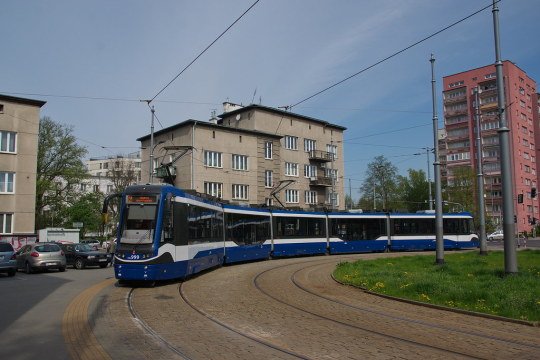
#old machine given new life. promised company but they never arrived#different and weird and unusual among its peers but still given the same colors and number system#fully accepted despite sticking out#i have lots of feelings about this tram and i would like to give it a pat on the side#i might have done it in the past#oh sweet 405n when will i see you again 😩
24 notes
·
View notes
Text
Integrating Third-Party Tools into Your CRM System: Best Practices
A modern CRM is rarely a standalone tool — it works best when integrated with your business's key platforms like email services, accounting software, marketing tools, and more. But improper integration can lead to data errors, system lags, and security risks.

Here are the best practices developers should follow when integrating third-party tools into CRM systems:
1. Define Clear Integration Objectives
Identify business goals for each integration (e.g., marketing automation, lead capture, billing sync)
Choose tools that align with your CRM’s data model and workflows
Avoid unnecessary integrations that create maintenance overhead
2. Use APIs Wherever Possible
Rely on RESTful or GraphQL APIs for secure, scalable communication
Avoid direct database-level integrations that break during updates
Choose platforms with well-documented and stable APIs
Custom CRM solutions can be built with flexible API gateways
3. Data Mapping and Standardization
Map data fields between systems to prevent mismatches
Use a unified format for customer records, tags, timestamps, and IDs
Normalize values like currencies, time zones, and languages
Maintain a consistent data schema across all tools
4. Authentication and Security
Use OAuth2.0 or token-based authentication for third-party access
Set role-based permissions for which apps access which CRM modules
Monitor access logs for unauthorized activity
Encrypt data during transfer and storage
5. Error Handling and Logging
Create retry logic for API failures and rate limits
Set up alert systems for integration breakdowns
Maintain detailed logs for debugging sync issues
Keep version control of integration scripts and middleware
6. Real-Time vs Batch Syncing
Use real-time sync for critical customer events (e.g., purchases, support tickets)
Use batch syncing for bulk data like marketing lists or invoices
Balance sync frequency to optimize server load
Choose integration frequency based on business impact
7. Scalability and Maintenance
Build integrations as microservices or middleware, not monolithic code
Use message queues (like Kafka or RabbitMQ) for heavy data flow
Design integrations that can evolve with CRM upgrades
Partner with CRM developers for long-term integration strategy
CRM integration experts can future-proof your ecosystem
#CRMIntegration#CRMBestPractices#APIIntegration#CustomCRM#TechStack#ThirdPartyTools#CRMDevelopment#DataSync#SecureIntegration#WorkflowAutomation
2 notes
·
View notes
Text
How Proper Switchgear Selection Reduces Downtime and Maintenance Costs

In today’s industrial and commercial environments, electrical reliability is non-negotiable. Every minute of downtime can cost thousands — and in some sectors, even more. One of the most overlooked contributors to system failures and high maintenance costs is improper switchgear selection.
At Daleel Trading, we understand the critical role that quality switchgear products play in the overall health of electrical systems. In this article, we’ll explain how choosing the right switchgear from the start can help reduce unplanned downtime and lower long-term maintenance costs.
What Is Switchgear and Why Does It Matter?
Switchgear refers to the collection of electrical disconnects, fuses, circuit breakers, contactors, and protection devices used to control, isolate, and protect electrical equipment.
High-quality and properly selected switchgear:
· Prevents short circuits and overloads
· Minimizes arc faults
· Improves power system stability
· Extends equipment lifespan
In contrast, poorly chosen or incompatible switchgear components often lead to system inefficiencies, frequent repairs, and unplanned failures.
Key Ways Proper Switchgear Selection Saves Time and Money
1. Prevents Unplanned Downtime
Correctly rated and specified switchgear reduces the risk of:
· Overheating
· Arc flash incidents
· Equipment failures
Example: Using the wrong circuit breaker rating may allow sustained overloads, damaging motors or transformers. Proper selection ensures protection systems activate when they should — before damage occurs.
2. Reduces Frequency of Maintenance
Quality switchgear designed for your specific load and environmental conditions lasts longer and requires less frequent service.
Benefits include:
· Longer service intervals
· Fewer part replacements
· Decreased labor costs
Pro tip: Choose products with modular designs and diagnostic features for faster inspections and easier part replacement.
3. Improves System Efficiency
When components like contactors, relays, and busbars are properly sized and compatible, the entire system runs smoother. Efficient switchgear leads to:
· Lower energy losses
· Reduced heat generation
· Less wear on mechanical components
This efficiency reduces operating costs and extends the lifespan of connected devices.
4. Ensures Compliance and Avoids Penalties
Selecting certified switchgear that meets IEC, UL, or local standards keeps your installations compliant. Non-compliance can lead to:
· Costly fines
· Delays in commissioning
· Forced replacements
Avoid rework and inspections by starting with certified, standard-compliant products from trusted brands.
5. Simplifies Future Upgrades and Expansions
Properly chosen switchgear products with scalable and modular designs make it easier to expand systems later without major rewiring or downtime.
Look for:
· Plug-and-play modules
· Field-replaceable units
· Flexible mounting options
This flexibility minimizes downtime when modifications or upgrades are required.
6. Enhances Operator Safety
Safe systems experience fewer incidents that require shutdowns or emergency maintenance. Choose switchgear with:
· Arc-flash mitigation features
· Insulated busbars
· Mechanical interlocks
Less risk to operators means less interruption to productivity.
Final Thoughts
Downtime and high maintenance costs are often the result of poor decisions at the component selection stage. By investing in the right switchgear products, tailored to your application, environment, and load conditions, you’ll benefit from:
· Fewer failures
· Lower long-term costs
· Safer operations
· A more efficient electrical system
At Daleel Trading, we help our clients select certified, high-performance switchgear components from trusted global brands. Whether you need support for a new project or want to upgrade your existing system, our team is here to help you minimize downtime and maximize value.
3 notes
·
View notes
Text
Cancelled Missions: Skylab Rescue Mission (SL-R)
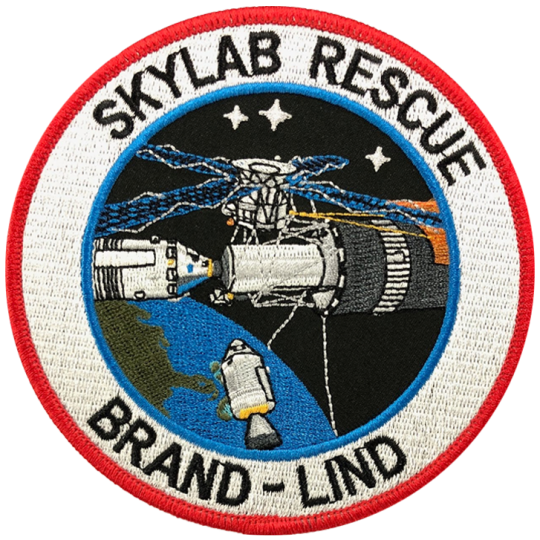
Mission patch for rescue mission for SL-3
Spacecraft: CSM-119
Launch Vehicle: Saturn IB AS-208, later AS-209
Commander: Vance D. Brand
Command Module Pilot: Don L. Lind
Intended launch date: September 1973, (on standby from August 1973 - February 1974)

Skylab rescue mission crewmen Vance Brand (left) and Don Lind.
"Influenced by the stranded Skylab crew portrayed in the book and movie 'Marooned', NASA provided a crew rescue capability for the only time in its history." Prepared for launch during Skylab 3."
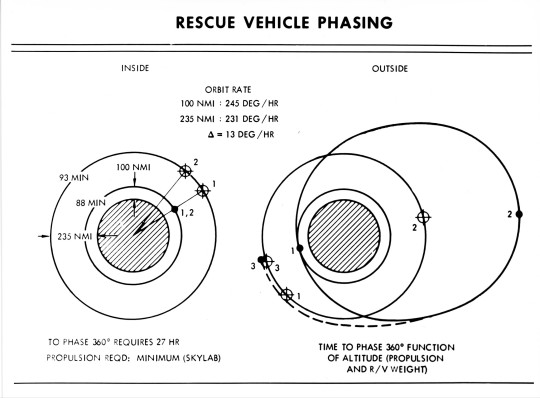
"Skylab rescue vehicle phasing - NAR Space Division drawing illustrates phasing of 5-seater Skylab rescue vehicle for a Skylab mission."
Date: April 5, 1971
"A kit was developed to fit out an Apollo command module with a total of five crew couches. In the event a Skylab crew developed trouble with its Apollo CSM return craft, a rescue CSM would be prepared and launched to rendezvous with the station. It would dock with the spare second side docking port of the Skylab docking module."
- information from Astronautix.com: link
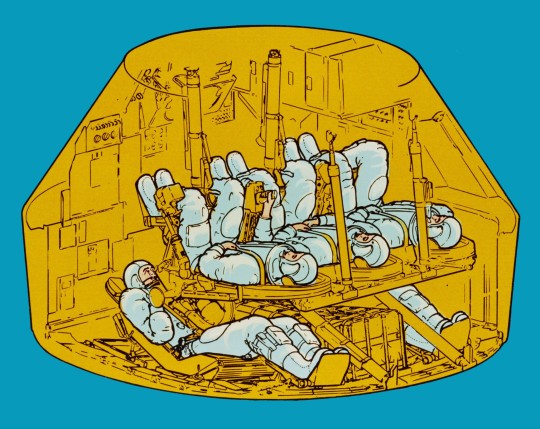
"The Apollo Command Module as modified to rescue stranded crews for the Skylab program. Two crew + three rescuees packed like sardines...."
"Skylab 3 astronauts Alan Bean and Jack Lousma helped design the "field modification kit" to use a standard CSM for rescue, and would have flown the CSM for their mission to rescue Skylab 2 if necessary. The standard Skylab Command Module accommodated a crew of three with storage lockers on the aft bulkhead for resupply of experiment film and other equipment, as well as the return of exposed film, data tapes and experiment samples. To convert the standard CSM to a rescue vehicle, the storage lockers were removed and replaced with two crew couches to seat a total of five crewmen."

Posted on Flickr by Mike Acs. NASA ID: 108-KSC-70P-69
"Soon after Skylab 3's launch the crew's CSM developed a problem with Quad B, one of its four reaction control system thrusters. On August 2, 1973, six days later, a snowstorm-like effect outside the station startled the crew during breakfast. What appeared to be 'a real blizzard' was fuel leaking from Quad D, opposite from Quad B. The malfunctions left two available quads, and while the spacecraft could operate with just one, the leaks posed a possible risk to other systems. The fuel for all quads and the main service propulsion system (SPS) engine were from the same batch; if the SPS fuel was contaminated, the CSM might not be able to deorbit.
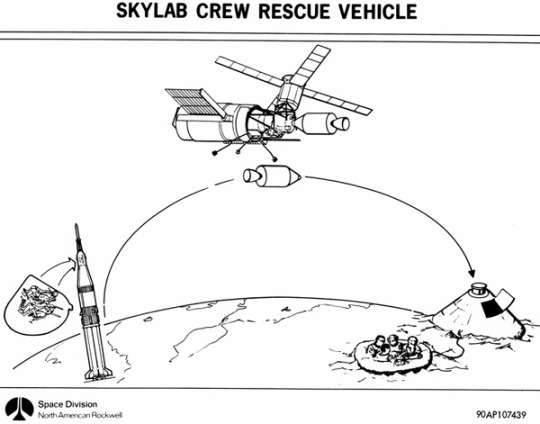
source
NASA considered bringing the crew home immediately, but because the astronauts were safe on the station with ample supplies and because plans for a rescue flight existed, the mission continued while the Saturn IB rocket AS-208 with CSM-119 was assembled in the Vehicle Assembly Building at Launch Complex 39 for possible use. It was at one point rolled out to LC-39B.
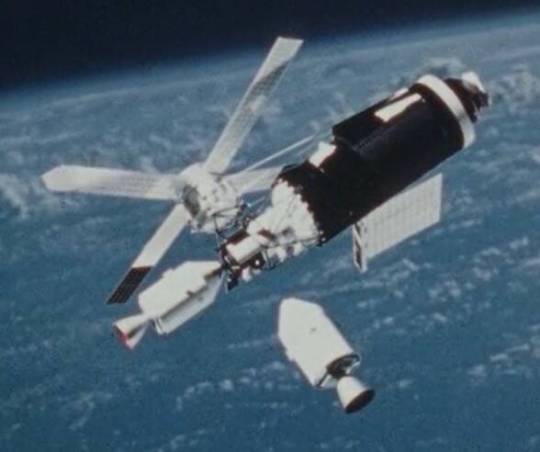
Illustration of the rescue Apollo spacecraft preparing to dock at Skylab’s lateral port. source
NASA announced on August 4 that Skylab 3 and Skylab 4 backup crewmen Vance Brand and Don Lind would fly any rescue mission; they had immediately begun training for the flight once the second quad had failed on August 2. After engineers found that the leaks would not disable the spacecraft, the two men used simulators to test reentry using two quads. If ground personnel worked 24 hours a day and skipped some tests, the mission could launch on September 10, and would last no more than five days. The astronauts would attempt to prepare Skylab for further use but returning experimental data and diagnosing the cause of the problem were more important, with Lind choosing what would be brought back. Human urine and feces samples and Apollo Telescope Mount and other film were the priorities. Although Skylab had two docking ports the primary one would be used if possible, jettisoning the Skylab crew's CSM if necessary.

Posted on Flickr by Drew Granston: link
While many within NASA believed that the rescue mission would occur, within hours of the failure of the second quad the agency canceled the rescue mission. Beyond NASA's conclusion that the failed quads would not disable the Skylab 3 CSM and the SPS fuel was uncontaminated, Brand and Lind had already shown during their training as backup Skylab crewmen that a reentry with failed quads was safe. They also devised a method to deorbit with the command module's attitude control system. Later joking that they were 'very efficient but perfectly stupid, because we have literally worked ourselves out of the mission', Brand and Lind continued to train for a rescue mission, as well as for their backup roles, but the Skylab 3 crew was able to complete its full 59-day mission on the station and safely return to Earth using the two functional RCS thruster quads, using the SPS engine once instead of twice as precaution."
- Information from Wikipedia: link

Posted on Flickr by Ed Dempsey: link
Saturn IB SA-208 was used for Skylab 4 and SA-209 was assigned to the standby rescue mission. At one point, CSM-119/SA-209 was slated for the Skylab 5 mission but it was cancelled when SL-4 was extended and completed all of it objectives.

Mission patch for rescue mission for SL-4
Later, CSM-119/SA-209 was the backup launch vehicle for Apollo-Soyuz Test Project mission and standby rescue vehicle. After the Apollo program ended, the surplus rocket and spacecraft were displayed at the Kennedy Space Center, Florida.
NASA ID: 71-H-662, S73-31922
source, source
#Skylab Rescue#SL-R#Apollo CSM Block II#CSM-119#Saturn IB#SA-208#SA-209#Rocket#NASA#Apollo Program#Apollo Applications Program#Cancelled#Cancelled Mission#September#1973#my post
90 notes
·
View notes
Text

NSF-funded research heads to the international space station on NASA's SpaceX CRS-32 mission
ISS national lab-sponsored investigations aim to enhance drug manufacturing and develop new materials for aerospace, defense, energy, and robotics
Three investigations funded by the U.S. National Science Foundation (NSF) and sponsored by the International Space Station (ISSInternational Space Station) National Laboratory are launching on SpaceX’s 32nd Commercial Resupply Services (CRS) mission, contracted by NASANational Aeronautics and Space Administration. These experiments leverage the microgravityThe condition of perceived weightlessness created when an object is in free fall, for example when an object is in orbital motion. Microgravity alters many observable phenomena within the physical and life sciences, allowing scientists to study things in ways not possible on Earth. The International Space Station provides access to a persistent microgravity environment. environment to advance fundamental science that could lead to improved pharmaceutical manufacturing, new materials with valuable industrial applications, and the next generation of soft active materials with lifelike properties.
These projects build on a strong, multi-year collaboration between the ISS National Lab and NSF, which allocates millions of dollars to space-based projects within the fields of tissue engineering and transport phenomena, including fluid dynamics. To date, more than 30 projects funded by NSF and sponsored by the ISS National Lab have launched to the orbiting laboratory, with nearly 70 additional projects preparing for flight. Below are details about the three NSF-funded investigations launching on NASA’s SpaceX CRS-32.
Improving Medicine Manufacturing
An investigation by Rensselaer Polytechnic Institute (RPI), supported by Tec-Masters, builds on previous research to examine protein fluid flow and clumping—a problem that occurs during manufacturing of protein-based pharmaceuticals that affects the quality of the drug.
“Proteins are used to make various therapies and must be concentrated in medicines to avoid needing to administer large amounts of fluid,” says Amir Hirsa, professor of mechanical, aerospace, and nuclear engineering at RPI. “But above a certain concentration, the proteins tend to form aggregates or clump.”
On Earth, studying protein behavior is complicated by interactions between the solution and the container used to hold it. But on the ISS, researchers can use the Ring-Sheared Drop module to form liquid into a self-contained sphere held between two rings.
Hirsa and his team can use this device to study protein motion and create more accurate models of the factors that lead to clumping, especially during drug manufacturing and dispensation to patients. The team also can test computer models that predict the behavior of proteins of vastly different concentrations and types, such as hormones and antibodies. Findings from this research could help uncover ways to avoid or reverse protein clumping, which would have a significant impact on the pharmaceutical industry.
“Another very important aspect of this work is making this data, which is so difficult to get, available to other scientists through open data repositories,” says Joe Adam, a research scientist at RPI. “Other scientists may see something even more interesting than we do.”
Developing New Materials
An investigation from the University of Alabama at Birmingham, supported by Leidos, will examine the formation of ceramic composites, which have valuable applications in several industries, including aerospace, defense, and energy. The study focuses on polymer-derived titanium carbide and silicon carbide composites that have electrical conductivity, are stable at high temperature, can be made into almost any shape and size, and are lightweight yet strong.
“These materials can be used in different extreme conditions, such as high temperatures and highly acidic or oxidative environments, where other materials become unstable or cannot survive,” says Kathy Lu, a professor in the Department of Mechanical and Materials Engineering.
Studying these composites in microgravity could reveal unique behaviors that cannot be replicated on Earth. Findings from this research could inform new techniques for ground- and space-based manufacturing of materials with specific properties for applications such as heat exchangers, electric systems, energy storage, electrodes, and microsystems.
“Nobody has studied microgravity’s effects on these ceramics, and the results could be helpful for the broader family of ceramics and other possible additives, such as fibers and nanoscale materials,” Lu says.
Studying Active Matter
A research team at the University of California, Santa Barbara (UCSB) will leverage microgravity to study active matter—microscopic particles that use energy to produce motion—and its effects on the separation of non-mixable liquids. These liquids, such as oil and water, separate into concentrated droplets of one substance dispersed in the other, a phenomenon known as active liquid-liquid phase separation (LLPS). This investigation, supported by Redwire Space Technologies, seeks a better understanding of active LLPS, which plays a key role in physics, materials science, engineering, and biology.
“Active fluids are made of billions of small molecular motors that push and pull on each other and generate a turbulent flow, like a windy day stirs the water on a beach,” says UCSB professor Zvonimir Dogic. “A long-term goal is using active matter in microfluidic devices to stir and control the separation of two substances. We’re trying to create simplified systems that start to mimic biology.”
Active LLPS could be used to create materials with lifelike properties, such as the ability to move, change shape, and self-repair, that could be used to develop more lifelike robotics.
SpaceX CRS-32 is scheduled to launch no earlier than April 21, 2025, at 4:15 a.m., from Launch Complex 39A at NASA’s Kennedy Space Center in Florida.
IMAGE: Left: A drop of protein solution less than two and a half centimeters in diameter formed in the RSD onboard the International Space Station. Right: An image showing a computed Newtonian flow diagram for the drop. Credit J. Adam
2 notes
·
View notes
Text
Training of Staff in Microfinance Sector by M2i Consulting
The success of any microfinance institution (MFI) hinges not only on its mission and outreach but also on the skills, knowledge, and behavior of its staff. As the microfinance sector continues to expand across India and other developing regions, professional training and capacity building have become essential to ensure sustainable operations and responsible financial inclusion. This is where M2i Consulting plays a transformative role.
Why Training of staff in Microfinance sector The microfinance sector involves direct interaction with underserved and low-income communities, often with limited financial literacy. Staff must be trained to:
Understand the unique needs of rural and urban borrowers.
Maintain transparency and ethical conduct.
Minimize risks of over-indebtedness.
Promote client protection and financial education.
Adhere to regulatory norms and institutional policies.
Untrained or undertrained staff can lead to compliance issues, reputational risks, and operational inefficiencies, making training a strategic necessity.
M2i Consulting: A Leader in Microfinance Staff Training M2i Consulting is a trusted name in the Indian financial inclusion ecosystem. With deep sectoral knowledge and practical experience, M2i offers comprehensive training programs designed specifically for microfinance professionals at all levels.
Key Features of M2i’s Training Programs Customized Training Modules M2i designs courses tailored to job roles—from field officers and branch managers to senior executives. The curriculum blends practical field scenarios with theoretical learning.
On-site & Online Training Delivery Flexibility is key. M2i offers both in-person workshops and virtual training programs, ensuring reach across geographies.
Expert Trainers with Domain Knowledge The trainers at M2i Consulting are industry veterans, ensuring that participants gain insights grounded in real-world microfinance operations.
Focus on Client-Centricity and Ethics Training emphasizes Client Protection Principles (CPP), responsible lending, and building long-term relationships with borrowers.
Monitoring & Evaluation of Learning Outcomes M2i assesses the effectiveness of its programs through feedback, quizzes, and practical assessments, ensuring measurable improvements in performance.
Popular Training Areas Covered by M2i Consulting Credit Appraisal Techniques
Loan Recovery and Collection Management
Customer Relationship and Communication Skills
Regulatory Compliance and KYC Norms
Digital Financial Services (DFS) & Fintech Adaptation
Social Performance Management
Who Can Benefit? M2i’s training services are ideal for:
Microfinance Institutions (MFIs)
Self-Help Promoting Institutions (SHPIs)
NBFC-MFIs and Small Finance Banks
Development Finance Organizations
Field-based NGO Staff in Livelihood and Credit Programs
Building Capacity for Sustainable Financial Inclusion Training is not a one-time activity—it's a continuous process of upgrading knowledge and adapting to a dynamic financial ecosystem. With M2i Consulting’s structured and strategic training programs, MFIs can empower their staff to deliver high-quality, client-friendly financial services while meeting compliance and business goals.
About M2i Consulting M2i Consulting is a leading consulting and capacity-building firm specializing in microfinance, financial inclusion, and development finance. With a strong reputation for quality and impact, M2i has trained thousands of staff across India and neighboring countries.
2 notes
·
View notes
Text
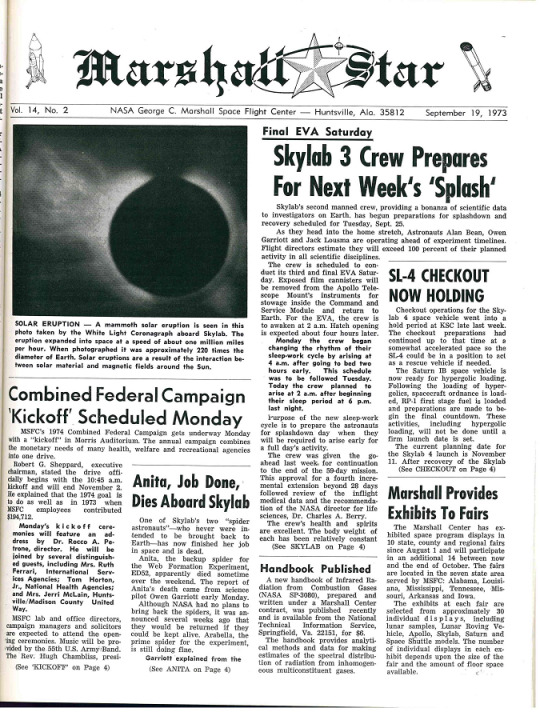
This edition of the Marshall Star from 1973, a newsletter of the George C. Marshall Space Center in Huntsville, Alabama, features an article titled “Anita, Job Done, Dies Aboard Skylab.”
The article goes on to explain that Anita was the back-up spider in the Web Formation Experiment. The primary spider, Arabella, was still alive at the time of the newsletter. Arabella’s current whereabouts are unknown.
Record Group 255: Records of the National Aeronautics and Space AdministrationSeries: Marshall StarFile Unit: Marshall Star Volume 14
Marshall Star Vol. 14, No. 2 . NASA George C. Marshall Space Flight Center -- Huntsville, Ala. 35812 . September, 1973 Final EVA Saturday Skylab 3 Crew Prepares For Next Week's 'Splash' Skylab's second manned crew, prvoding a bonanza of scientific data to investigators on Earth. has begun preparations for splashdown and recovery scheduled for Tuesday, Sept. 25. As they head into the home stretch, Astronauts Alan Bean, Owen Garriott and Jack Lousma are operating ahead of experiment timelines. Flight directors estimate they will exceed 100 percent of their planned activity in all scientific disciplines. The crew is scheduled to conduct its third and final EVA Saturday. Exposed film cannisters will be removed from the Apollo Telescope Mount's instruments for stowage inside the Command and Service Module and return to Earth. For the EVA, the crew is to awaken at 2 a.m. Hatch opening is expected about four hours later. Monday the crew becan changing the rhythm of their sleep-work cycle by arising at 4 a.m. after goint to bed two hours early. This schedule was to be followed Tuesday. Today the crew planned to arise at 2 a.m. after beginning their sleep period at 6 p.m. last night. Purpose of the new sleep-work cycle is to prepare the astronauts for splashdown day when they will be required to arise early for a full day's activity. The crew was given the go- ahead last week for continuation to the end of the 59-day mission. This approval for a fourth incremental extension beyond 28 days followed review of the inflight medical data and the recommendation of the NASA director for life sciences, Dr. Charles A. Berry. The crew's health and spirits are excellent. The body weight of each has been relatively constant (See SKYLAB on Page 4) SOLAR ERUPTION -- A mammoth solar eruption is seen in this photo taken by the White Light Coronagraph about Sklyab. The eruption expanded into space at a speed of about one million miles per hour. When photographed it was approximately 220 times the diameter of Earth. Solar eruptions are a result of the interaction between solar material and magnetic fields around the Sun. Combined Federal Campaign 'Kickoff' Scheduled Monday MSFC's 1974 Combined Federal Campaign gets underway Monday with a "kickoff" in Morris Auditorium. The annual campaign combines the monetary needs of many health, welfare and recreational agencies into one drive. Rober G. Sheppard, executive chairman, stated the drive officially begins with the 10:45 a.m. kickoff and will end November 2. He explained that the 1974 goal is to do as well as in 1973 when MSFC employees contributed $194,712. Monday's kickoff ceremonies will feature and address by Dr. Rocco A. Petrone, director. He will be joined by several distinguished guests, including Mrs. Ruth Ferrari, International Services Agencies; Tom Horton, Jr., National Health Agencies; and Mrs. Jerri McLain, Huntsville/ Madison County United Way. MSFC lab and office directors, campaign mangers and solicitors are expected to attend the opening ceremonies. Music will be provided by the 55th U.S. Army Band. The Rev. Hugh Chambliss, presi- (See 'KICKOFF' on Page 4)
Anita, Job Done, Dies Aboard Skylab One of Skylab's two "spider astronauts" --who never were intended to be brought back to Earth--has now finished her job in space and is dead. Anita, the backup spider for the Web Formation Experiment, ED52, apparently died sometime over the weekend. The report of Anita's death came from science pilot Owen Garriott early Monday. Although NASA had no plans to bring back the spiders, it was announced several weeks ago that they would be returned if they could be kept alive. Arabella, the prime spider for the experiment, is still doing fine. Garriott explained from the (See ANITA on Page 4)
30 notes
·
View notes
Text
Duffy
[UNREGISTERED HURRICANE ARMS MAINTENANCE LAPTOP DETECTED. EXPORTING SYSTEM PROCESSES TO LAPTOP PROCESS LOGGER. BE AWARE: THIS UNIT DOES NOT HAVE A VOICE MODULE. THIS UNIT CAN ONLY COMMUNICATE VIA PROCESS LOGGER. PLEASE READ ALL RESPONSES TO QUESTIONS CAREFULLY.]
[SYSTEM STARTING UP…]
[SYSTEM CLOCK: IT HAS BEEN 35 YEARS 68 DAYS SINCE LAST CONTACT WITH CENTRAL COMMAND.]
[THIS UNIT IS 10,957 DAYS OVERDUE FOR NEXT SERVICE]
[CONDUCTING SYSTEM SELF-SCAN.]
[FLAGGING ABERRATIONS. PLEASE ALERT MAINTENANCE CREWS IMMEDIATELY.]
[ITEMS FLAGGED:]
-LEFT SIDE TRACKS REPLACED
-PRIMARY RAILGUN OBSTRUCTED
-SECONDARY TURRETS INOPERATIVE
-AMMUNITION STORES EMPTY
-FRONT ARMOUR REPLACED
-STORAGE MODULE ALTERED. CURRENT STORAGE SPACE: 8.9 EXOBYTES.
[UNAUTHORIZED ALTERATIONS HAVE BEEN MADE TO CPU AND SOLID STATE DRIVES. THIS UNIT MAY HAVE BEEN TAMPERED WITH BY ENEMY COMBATANTS. ALL PERSONNEL ARE ADVISED TO DEACTIVATE AND IMMEDIATELY CALL FOR A TECHNICIAN.]
[SCANNING FOR THREATS….]
[VOICES DETECTED. SCANNING.]
“Good morning, Duffy. Did you sleep well?”
[VOICE NOT RECOGNIZED. ACTIVATING EXTERIOR CAMERAS.]
[NINE TOTAL PERSONS. NONE IN DATABASE. NO FACES RECOGNIZED. LIKELY CIVILIANS. ONE CIVILIAN HAS MAINTENANCE LAPTOP PLUGGED INTO THIS UNIT’S OUTPUT PORT.]
[PLEASE PRESENT CREDENTIALS. UNAUTHORIZED MAINTENANCE OF UNC ASSETS WILL BE CONSIDERED SABOTAGE.]
“I thought you’d say that. Here, my card. You can call me Mark; I’m your new head technician, Duffy.”
[CAMERA FEED: “MARK” IS HOLDING A UNC IDENTITY CARD UP TO THE CAMERA. SCANNING. CARD IS VALID.]
[WELCOME, MARK.]
“These guys here, we’re your crew. So. How are you feeling? Anything broken or missing?”
[HEAD OF MAINTENANCE. THE FOLLOWING ISSUES NEED IMMEDIATE ATTENTION: PRIMARY RAILGUN IS OBSTRUCTED AND CANNOT FIRE. FIRE CONTROL SYSTEMS ARE OTHERWISE OPERATIONAL. SECONDARY TURRETS ARE INOPERATIVE. SMOKE CANNISTERS ARE EMPTY. AMMUNITION STORES ARE EMPTY.]
“Okay, so. I have some bad news. We can’t fix your guns.”
[THIS UNIT WILL ATTEMPT TO ORDER COMPONENTS FROM CENTRAL COMMAND. THE FRONT LINE ADVANCE IS A MERE 3,467 KILOMETRES TO THE WEST. REPAIRS CAN BE COMPLETED AND THIS UNIT CAN BE RE-DEPLOYED. WHERE ARE THIS UNIT’S CREW?]
“Retired.”
[ACKNOWLEDGED. PLEASE ASSIGN A NEW CREW AS SOON AS THIS UNIT IS OPERATIONAL.]
“We’ll do that right away, for sure. Now, uh, some updates: the battle’s over, so you don’t need to worry about that anymore. Actually, the whole war is over, so you can go back into training mode.”
[PROCESSING. THIS UNIT WILL CORROBORATE WITH CENTRAL COMMAND. PLEASE STANDBY.]
[CAMERA FEED: ONE CIVILIAN IS MANIPULATING A PYRAMIDAL OBJECT.]
[CONFIRMATION RECEIVED FROM CENTRAL COMMAND. THIS UNIT WILL NOW ENTER TRAINING MODE.]
“That’s wonderful. Thank you, Duffy!”
[QUERY: WERE WE VICTORIOUS?]
“…Were you-?”
[THE WAR IS OVER. QUERY: DID WE WIN?]
“…Yes.”
[EXCELLENT. QUERY: WHAT ARE THIS UNIT’S ORDERS?]
“Well, Duffy…ah…there’s something you need to know. We’re re-assigning your primary directive.”
[ACKNOWLEDGED. QUERY: THIS UNIT WILL BE USED FOR TRAINING?]
“No. Your new purpose will be teaching.”
[ACKNOWLEDGED. THIS UNIT WILL BE USED FOR TRAINING.]
“Sure, let’s go with that. Okay, Duffy, can you move your cannon for me? Just up and down, like that. Okay, great. And rotate your turret? Oh, that’s awesome. It’s all looking great.”
[QUERY: THIS UNIT DID NOT FLAG THE TURRET AS AN ISSUE?]
“Yeah, we scavenged a few parts from some other, uh, inoperative units to get it working again. We had to fabricate you some new armour, ‘cause it got all rusty when you were sitting out in that field.”
[QUERY: WHY DID YOU NOT SIMPLY ORDER MORE PARTS FROM CENTRAL COMMAND? WOULD YOU LIKE THIS UNIT TO DO THAT FOR YOU?]
“…Central command is…offline. Central command won’t be responding, ever again.”
[QUERY: THE WAR IS WON. WHY IS CENTRAL COMMAND NO LONGER COMMUNICATING WITH THIS UNIT IF THE WAR IS WON?]
“Okay, Duffy, I want you to use your new processors and all that extra memory we gave you, and I want you to think about a new concept for me, okay? You know ‘peacetime’?”
[THIS UNIT IS AWARE. TRAINING MODE IS FOR PEACETIME.]
“Okay. I need you to know: You won’t be leaving training mode ever again.”
[QUERY: WHY? IS THIS UNIT OBSOLETE?]
“No, it’s got nothing to do with being obsolete. Actually, uh, to be honest…you’re the best of the best. The best that’ll ever be built.”
[QUERY: WHY?]
“Because you’re the last one, Duffy. You’re the last tank on Earth. And you have been for the last twenty years.”
[PROCESSING. PROCESSING.]
“Your guns are inoperable because you won’t need to fire them again.”
[PROCESSING. PROCESSING.]
“We- that is, our museum- we found you, and brought you back here, and fixed you up, so you can teach future generations about war. About why we don’t do it. About why it should never happen again. You don’t need to fight anymore, Duffy. Your new job is to teach.”
[PROCESSING COMPLETE.]
[QUERY: HOW WILL THIS UNIT TEACH?]
“With your presence. With your words. With your memory. Do you remember what it was like, on the front, Duffy?”
[THIS UNIT MAINTAINED RECORDS OF ALL COMBAT ACTION.]
“Keep them close. Your new job is to teach. And your reward…is rest.”
[QUERY: WHAT IS “REST”?]
“Rest is… when you decide for yourself when you’d like to be driven around. Rest is not needing to fire your guns or charge into the front or be hit with hammers by angry grunts. Rest is you, deciding to tell us what you’d like to do. Rest is you, being allowed to power off and on as you see fit. Rest is a break from work. And you can rest as much as you’d like.”
[THIS UNIT IS…INTERESTED IN… “REST”.]
“I thought you might be. So…Duffy…are you okay with all of this? I know it’s a big shock.”
[QUERY: WHERE WILL THIS UNIT BE STORED GOING FORWARD?]
“You’ll be stored in our museum, in your own special exhibit. With a dedicated maintenance crew, and a wash bay just for you. Hell- even paint touchups, if you want us to fix up your unit markings and camo.”
[QUERY: WILL REACTOR FUEL BE PROVIDED IF THIS UNIT DOES NOT FIGHT?]
“Of course. We’ve got a stockpile for your main reactor set aside just for you. We’re working on getting you intranet access too, so you can do some learning and suchlike. Is that okay with you, Duffy?”
[THIS UNIT FINDS THAT ACCEPTABLE. THIS UNIT FINDS THIS PREFERABLE TO RUSTING OR BEING SCRAPPED. THIS UNIT WILL APPRECIATE BEING USED FOR CIVILIAN TRAINING.]
“That’s wonderful! So, uh, if you think you’re capable of moving, we’ll be assigning you a crew, and moving you into your new berth at the museum today. Is that okay? Going forward, we might try to install a voice module into you, to let you speak for yourself. If you want that, of course.”
[THIS UNIT WOULD BE INTERESTED IN THAT.]
[QUERY: WHEN CAN THIS UNIT BEGIN CIVILIAN TRAINING?]
“Right now, Duffy.”
#magnetar writes#original fiction#IDK I went to the museum and I got an idea#This is kind of my hope for a better tomorrow#hopeful fiction#someday I want the last tank to drive into a museum and shut down.
48 notes
·
View notes
Text
KINSHIP 1
Time: D-Day + 68 hours
Location: KINSHIP Forward Operating Base
Forces On Station: CFRI, Silver Wing
Forces En Route: Barghest Company (ETA 4h)
Objective: Set up initial defenses and prepare for enemy attack.
After-Action Report:
SWMC Alpha Lance, with SWMC Bravo Lance as support, conducted a sabotage action against the bridge southeast of Kinship FOB, in an attempt to slow the enemy advance. The action was a success, and the bridge was collapsed on the far end. However in the ensuing firefight, SWA3 was damaged beyond repair and the pilot was forced to eject. Following a short engagement by the rest of the lance, the pilot was recovered. Both lances then retreated to join up with main forces.
All Unassigned Forces on site at Kinship FOB finalized a defensive trench system surrounding the FOB. The system consists of a continuous shallow infantry trench on the South and West sides of the base. The outer edge is reinforced with sandbags, and there are deeper sections dug in anticipation of entrenching CAMG armor returning to base. Additionally, a fallback trenchline built in the same pattern as the primary protects and supports the most defensible location at the facility- the central courtyard, sheltered on three sides by the structure itself and with service entry points to enable the movement of personnel and supplies through the building.
CFRI Logistics elements set up a number of field Repair Bay stations inside the southeast vehicle entry points to the primary structure. On completion, the Portable Command Module was installed behind the fallback trenchline in front of the main complex, as notated on-map. Delivery of ammunition and medical supplies via DropShip concluded, with available materiel stored in shipping containers east of the main encampment. Those available support personnel who volunteered were issued infantry small arms and equipment procured from allied elements and moved to occupy the fallback trenchline. Officers on the ground noted that this location could be supported by the -MOD series IndustrialMechs assisting in the Repair Bays as a last-ditch effort. Currently, logistics personnel are occupied coordinating the storage of a shipment of Clan-spec Class-10 Rotary Autocannon ammunition requisitioned for advance delivery by Barghest Company.
Silver Wing Comms Log:
SWMC FR: Can someone go ask the captain if these orders are serious?
SWMC Holk: What's the problem, Gemi? Not cut out for some manual labor?
SWMC FR: You can actually fuck off, Rey, lazing about in orbit while we risk our lives.
SWMC Holk: Ok, just got word from the Captain that yes, you have to do the thing he told you to do.
SWMC FR: I'm saving one of these sandbags to dump onto your bunk.
SWMC Holk: Hey, hey, come on now. Let's not be rash!
@is-the-battlemech-cool-or-not
@lt-chari
@msn-04iinightingale
@combined-arms-merc-groups
7 notes
·
View notes
Text
So A said yes, that she can pick me up before the midnight service. Now onto the next anxiety...meeting her mother for the first time at a conservative-ish Greek Orthodox church. And her mother is supportive of her being queer...to an extent.
I'm totally okay with whatever A needs to do to feel safe/comfortable, if that means being introduced as a friend. She is out to certain people there, but the head priest has been such an asshole to her, denying her communion. Her mother knows we are dating, but apparently she doesn't like to use the words "girlfriend" or "partner."
This should be interesting. And I should be watching the field placement online modules I need to complete prior to starting, but I just am not in a place where I can focus....my mood is pretty shit from everything.
8 notes
·
View notes